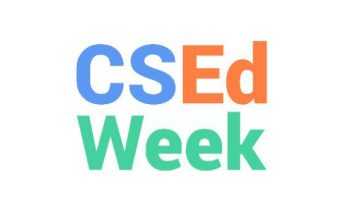“The BBC micro:bit – From the U.K. to the World”
Communications of the ACM,
Contributed Articles
By Jonny Austin, Howard Baker, Thomas Ball, James Devine, Joe Finney, Peli De Halleux, Steve Hodges, Michał Moskal, Gareth Stockdale
Since the initial distribution of micro:bits in 2016 we have observed significant interest, enthusiasm, and adoption. The BBC micro:bit is now available in 60 countries and 24 languages, and in excess of four million devices have been delivered to end users globally with an increasing demand year over year. The online editors have hundreds of thousands of independent sessions every month. Activity on social media and support networks also indicate high levels of use for micro:bit resources in schools, particularly those related to the constructionist pedagogy.
In 2015, the BBC launched the Make It Digital initiative, aiming to encourage a new era of creativity in the young using programming and digital technology as its medium. Simultaneously, the initiative also would support the U.K.’s mandate to teach computer science concepts at all grade levels.
The micro:bit is a small programmable and embeddable computer designed, developed, and deployed by the BBC and 29 project partners to approximately 800,000 U.K. Year 7 (11/12-year-old) school children in 2015-2016. Referring back to its work with the BBC Micro, the BBC described the micro:bit as its “most ambitious education initiative in 30 years, with an ambition to inspire digital creativity and develop a new generation of tech pioneers.”
Embracing a constructionist approach to computing education, the micro:bit has moved from a local educational experiment in the U.K. to a global effort driven by the Micro:bit Educational Foundation (microbit.org), a nonprofit organization established in September 2016. There are now over four million micro:bits in the market in over 60 countries with many hardware, content, and education partners participating.
The BBC and its partners developed the micro:bit as an inexpensive, powerful, and easy-to-use learning tool guided by five major design goals:
- Have a low barrier to entry. Financial cost and simplicity are important considerations for any technology, but even more so in an educational setting. The micro:bit needed to be affordable, easy to deploy, intuitive to use, simple to program, and integrate well with existing school IT infrastructure.
- Be fun and creative. The micro:bit itself needed to offer an exciting, engaging, inclusive introduction to coding and making. Inspired by Arduino and the Maker movement, the project sought to turn teachers and students from digital consumers into digital creators by integrating the micro:bit into their own real-world, physical creations.
- Have a low floor, high ceiling, and wide walls. When designing the micro:bit, providing good educational value to students and teachers was the prime consideration. It needed to be easy for inexperienced learners to get started (low floor); enable rich learning opportunities that grow with user expertise, provide progression in both programming language and application complexity (high ceiling); and enable students to reach the ceiling via multiple pathways to embrace a diverse audience (wide walls).
- Open a window into the future. Computing technology is becoming ever more ubiquitous, connected, and embedded. In the 1980s, the BBC Micro captured the essence of the devices that were to come over the next 30 years: the desktop PC. The micro:bit was designed as a modern-day equivalent, capturing the connected, embedded nature of devices that are to come for the next 30 years.
- Be applicable beyond computer science. Cross-curricular activities can offer diverse and inclusive learning. This is important when we consider the gender disparity in computing today. The micro:bit project aimed to stimulate curiosity about how computing can be applied across a variety of disciplines, ranging from science and technology/engineering to the arts and mathematics (STEAM).
In this article, we describe the design of the BBC micro:bit and the realization of these goals, exemplified through a sample set of diverse projects. We review the project’s history as it transitioned from a U.K.-centric to a worldwide project, concluding with lessons learned and project outcomes.
Sidebar: micro:bit Artifacts
The BBC micro:bit hardware and software assets are open source at https://github.com, at the following locations:
- /bbcmicrobit for the micro:bit hardware design, the micro:bit software prototype and the MicroPython port for the micro:bit;
- /microsoft/pxt-microbit for MakeCode for the micro:bit;
- /lancaster-university/microbit-dal for the micro:bit C++ runtime.
A wide variety of educational resources for the micro:bit can be found at https://microbit.org. Resellers of the micro:bit and accessory manufacturers can be found at https://microbit.org/resellers.
About the Authors:
- Jonny Austin is chief technology officer at the Micro:bit Educational Foundation, London, U.K.
- Howard Baker is an education researcher at the Micro:bit Educational Foundation, London, U.K.
- Thomas Ball is a partner researcher at Microsoft Research, Redmond, WA, USA.
- James Devine is a Ph.D. student in the School of Computing and Communications at Lancaster University, U.K.
- Joe Finney is a professor in the School of Computing and Communications at Lancaster University, U.K.
- Peli de Halleux is a principal research software development engineer at Microsoft Research, Redmond, WA, USA.
- Steve Hodges is a senior principal researcher at Microsoft Research, Cambridge, U.K.
- Micha Moskal is a principal research software development engineer at Microsoft Research, Redmond, WA, USA.
- Gareth Stockdale is chief executive officer at the Micro:bit Educational Foundation, London, U.K.






